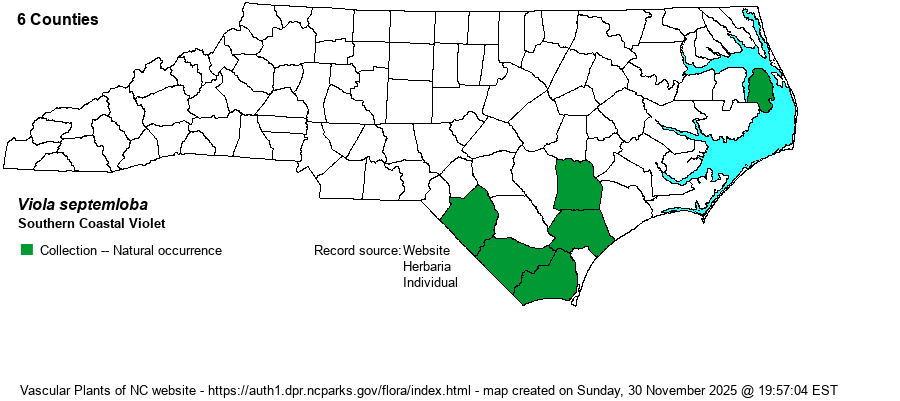| Author | LeConte | |
| Distribution | Present only in the southern Coastal Plain, east of the Sandhills region. Ranges north only to Robeson and Duplin counties. Specimens collected elsewhere (Bladen, New Hanover) are believed to be misidentifications. Harvey Ballard annotated NCU collections in July 2024 and verified V. septemloba from Brunswick, Columbus, Duplin, Pender, and Robeson counties. A specimen at NCSC collected by B. Bauers from mainland Dare County in 2002 and annotated by B. Wichmann appears to be correct. Other specimens (at SERNEC Sept. 2024) collected across NC are misidentified and actually are brittoniana, stoneana, fimbriatula, subsinuata, palmata, doubtful ID, or without an image. However, there are a handful of Research Grade photos on iNaturalist from the southeastern counties, in savanna habitat, that seem to corroborate its current existence in the state.
This is a Southern species, ranging north only to southeastern NC, and south to southern FL and west to LA. | |
| Abundance | Apparently rare anywhere in NC. The most recent specimen is from Brunswick County in 1987 and Dare County in 2002. This species is much rarer in NC than previously thought, with only a single specimen post-2000. For some reason, the NCNHP has not given a State Rank for the species. The website editors suggest S1S2, and probably a place on the Watch List. | |
| Habitat | This is primarily a pine savanna species in NC; it may occur in wet pine flatwoods, but this is the primary blue-violet flowered member of the genus found in pine savannas in NC. The habitat listed in Weakley (2018) -- "Sandy pinelands" -- probably applies to the species farther south, but this is not the habitat in NC. | |
| Phenology | Blooms from late March to early May, and fruits shortly after flowering. | |
| Identification | This is one of the more striking of our violets, with perhaps the largest flowers of all, easily noted where present in a pine savanna when in bloom, as few other species are in bloom that early in spring in this habitat. It is an acaulescent species, with the flowering stalks growing to about 6 inches tall, topped by a large flower that is about 1.5 inches tall and across. The leaves, all basal, are somewhat variable, though early ones are simply cordate and undivided. Most leaves are divided into three lobes, with the middle one wide, and lateral lobes often somewhat divided into smaller segments so as to appear to have 5 or 7 lobes (but with the middle one usually prominent and much wider than the others). The most similar species is V. palmata, but that is a forest species of mesic, usually hardwood, habitats; that species has the blades and petioles moderate to densely pubescent, as opposed to mostly glabrous in V. septemloba. Also, the lowermost lobe on the blade in V. palmata is "directed outward parallel to ground" (Weakley 2018), as opposed to "usually directed downward toward ground" in V. septemloba. The poorly known V. subsinuata, of Piedmont and mountain forests, has all leaves divided, with no ovate or cordate (undivided) ones. | |
| Taxonomic Comments | None
General note on Viola: In 2009-10 B.A. Sorrie (website map editor) went through the whole collection at NCU, annotating all specimens against those verified by experts in the genus. The range maps in RAB (1968) have been changed accordingly. More recently, Harvey Ballard and colleagues are in the process of revising all Eastern and Southeastern Viola, and have annotated all specimens at NCU in July 2024. They recognize additional species not in RAB or in previous editions of Weakley et al.; we will follow updated editions of Weakley et al. in recognizing them. Species range maps have been adjusted to account for identification changes. | |
| Other Common Name(s) | None | |
| State Rank | [S1S2] | |
| Global Rank | G3G5 | |
| State Status | [W7] | |
| US Status | | |
| USACE-agcp | FAC link |
| USACE-emp | FACW link |

